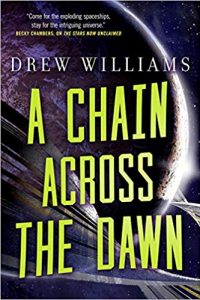Paul Di Filippo reviews Jyrki Vainonen and Leena Krohn
 The year 2014 will mark the thirtieth anniversary of the founding of Ministry of Whimsy Press by Jeff VanderMeer in 1984. That pre-internet era seems like an antique age sometimes, but the accomplishments of MofW endure. During its heyday, the house published a stimulating and eclectic range of books, such as Stepan Chapman’s Troika. But the press went into hibernation, as VanderMeer pursued other projects, including his own fine fiction, and although it exists now nominally as an imprint of Wyrm Publishing, its output is minimal.
The year 2014 will mark the thirtieth anniversary of the founding of Ministry of Whimsy Press by Jeff VanderMeer in 1984. That pre-internet era seems like an antique age sometimes, but the accomplishments of MofW endure. During its heyday, the house published a stimulating and eclectic range of books, such as Stepan Chapman’s Troika. But the press went into hibernation, as VanderMeer pursued other projects, including his own fine fiction, and although it exists now nominally as an imprint of Wyrm Publishing, its output is minimal.
Enter Cheeky Frawg Books, the latest venture by VanderMeer with life- and business-partner Ann VanderMeer. True gluttons for punishment, as well as dedicated embracers and purveyors and boosters of weird fiction, the VanderMeers have taken advantage of the e-book revolution to launch their new enterprise with less overhead and risk than in the days of strictly physical books. Already over a dozen books have sprung from Cheeky Frawg’s loins, including last year’s knockout Jagannath, by Karin Tidbeck. And for us fossils, the books are available sometimes in paperback as well.
The two newest titles reflect the VanderMeers’ smart and wide-ranging curatorial talents, which have stretched to Finland to bring back English translations of fascinating work by Jyrki Vainonen and Leena Krohn. (And the several deft translators involved here are due big thanks.)
Vainonen’s story collection will certainly cause savvy readers to instantly think of Zoran Živković, a brilliant fantasist from whom we have regrettably heard too little since his guest-of-honor stint at 2009’s World Fantasy Convention. Both men share the ability to conjure up the most pedestrian scenarios in intimate detail, and then send those mundane worlds into surreal chaos. Or, if not chaos, then into otherwordly and oblique patterns of enigmatic events that resonate more on the subconscious level than the intellect.
In “The Explorer” a man, desirous of getting closer to his distant wife, figures out a way literally to co-inhabit her body. Like some daft version of Fantastic Voyage, the story evokes somatic unease. Although nothing overtly unnatural occurs in “Blueberries,” sheer synchronicity propels the odd discovery made by a hermit-like man as he is out in a field picking fruit. Likewise, “The Aquarium” holds forth nothing precisely supernatural, but the descent into madness of the female protagonist and the manifestations of her paranoid jealousy assume titanic weirdness. Like some lost John Collier tale, “The Pearl” concerns a man whose job is to pose as a mannequin, and shows us step-by-step where that occupation leads him. Creepiest of all the tales is “The Garden,” which finds an adult son ministering unconcernedly to his parents as they undergo bizarre changes due to the effects of a mysterious plant. “The Library” is a Robinsonade set in the titular institution, and has a Twilight Zone feel about it. And finally, “The Refrigerator” charts the strange voyages of one Ahab, bus rider to nowhere, and his talismanic refrigerator.
Vainonen’s work is deceptively simple yet deep, radiating alien sunlight whose shadows hide terrors that are simultaneously glories.
Leena Krohn has been publishing since 1970, and the fact that her books are not better known in the English-speaking world is testament to the general blankness of the marketplace when it comes to authors in translation. Although her novel Tainaron: Mail From Another City did receive a WFA nomination, not much else has been available here until Datura.
This droll and delirious novel reminds me of nothing so much as John Sladek’s neglected masterpiece, “Masterson and the Clerks.” (And in fact Sladek might serve as one of the elder patron saints for Cheeky Frawg and its stable of authors.) Just as Sladek’s story centered around the workplace—an underused setting for strangeness—so does Datura. Our nameless narrator—female by some contextual clues, insofar as I can deduce—works for a magazine called The New Anomalist, which is a kind of Fortean/New Age journal. Naturally, this job brings her in contact with innumerable loonies and nonpareils, all of them lovingly characterized by Krohn with compassion and cheery acceptance.
But our heroine, though seemingly “normal,” is perhaps the biggest loony of all. She’s popping poisonously hallucinogenic datura seeds and trying to unravel the famously indecipherable Voynich Manuscript, while also managing the magazine’s mail-order “parastore” and editing the text of endless strange articles. This routine is causing her to slip across timelines into parallel cities, and to meet such inexplicable entities as “the woman who was [always] ahead of me.” The narrator’s ultimate fate is redemptive, but not painless.
Krohn’s chosen structure is a number of brief, enticingly swift chapters that function almost as independent stories, but which flow and build in subterranean fashion into a baroque tapestry of arcane effects. It’s definitely the account of a whole Joseph-Campbell-style journey, the Monomyth as warped by datura ingestion.
With these two new splendid offerings added to its catalog, the VanderMeers’ new publishing house assumes Escherian dimensions.






